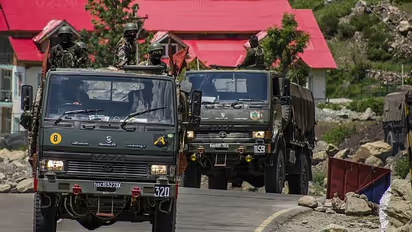Army tweaks posture along northern border after Eastern Ladakh standoff
In order to counter Chinese deployment along the Line of Actual Control, the Indian Army has made some changes on the northern borders after the troops of two countries engaged into border standoff in eastern Ladakh. Anish Singh reports

The rebalancing was made keeping future requirements in the mind as well.
As part of its structural change, the army has restructured its Panagarh-headquartered Mountain Strike Corps or 17 Corps which is having an ability to move, deploy and launch limited offensives in the mountains with quick reaction time.
During the annual press conference ahead of Army Day, Indian Army chief Gen MM Naravane had said, "Keeping the threat perception we have gone in for winter posture, winter deployment."
"The incident of eastern Ladakh has prompted the need for us to restructure and to enhance our capabilities," Gen Naravane said.
The rebalancing was made keeping future requirements in the mind as well.
As part of its structural change, the army has restructured its Panagarh-headquartered Mountain Strike Corps or 17 Corps which is having an ability to move, deploy and launch limited offensives in the mountains with quick reaction time.
During the annual press conference ahead of Army Day, Indian Army chief Gen MM Naravane had said, "Keeping the threat perception we have gone in for winter posture, winter deployment."
"The incident of eastern Ladakh has prompted the need for us to restructure and to enhance our capabilities," Gen Naravane said.
Speaking about the rebalancing done in eastern Ladakh, the Army chief said that based on the reviews of the threat, a certain amount of rebalancing does happen.
"This is a continuous and ongoing process and as the events on Eastern Ladakh have shown that there was indeed a requirement of carrying out a certain amount of rebalancing towards our northern borders and that is what we have now put into place," he said in reply to a question.
On the sidelines of the press conference, the chief said to a group of reporters that there will be no divisions format in Mountain Strike Corps but the troops will be organised into 3-4 Integrated Battle Groups (IBGs).
"We will have three-four Integrated Battle-Groups as part of the 17 Corps."
Speaking about the rebalancing done in eastern Ladakh, the Army chief said that based on the reviews of the threat, a certain amount of rebalancing does happen.
"This is a continuous and ongoing process and as the events on Eastern Ladakh have shown that there was indeed a requirement of carrying out a certain amount of rebalancing towards our northern borders and that is what we have now put into place," he said in reply to a question.
On the sidelines of the press conference, the chief said to a group of reporters that there will be no divisions format in Mountain Strike Corps but the troops will be organised into 3-4 Integrated Battle Groups (IBGs).
"We will have three-four Integrated Battle-Groups as part of the 17 Corps."
The division is usually commanded by a Major General, comprised of 3-4 brigades and included 10,000 to 15,000 soldiers. However, in the IBG concept, there will be around 4,000-5,000 troops.
The Army plans to have 12-13 IBGs and additional resources will also be provided.
The aim of the IBGs is to be agile, self-sufficient combat formations so that they can quickly launch strikes against an adversary in case of hostilities. Each IBG would be tailor-made based on terrain, task and threat.
It has been kept light so that they can be able to get ready for combat role within 12-48 hours.
The division is usually commanded by a Major General, comprised of 3-4 brigades and included 10,000 to 15,000 soldiers. However, in the IBG concept, there will be around 4,000-5,000 troops.
The Army plans to have 12-13 IBGs and additional resources will also be provided.
The aim of the IBGs is to be agile, self-sufficient combat formations so that they can quickly launch strikes against an adversary in case of hostilities. Each IBG would be tailor-made based on terrain, task and threat.
It has been kept light so that they can be able to get ready for combat role within 12-48 hours.
The new IBG format has already been tested during a major drill "Him Vijay" in the eastern theatre in 2019, in order to validate the concept of a swift offensive in the high altitude along the Line of Actual Control.
It is pertinent to mention here that India and China share a 3,488-km-long border, starting from Arunachal Pradesh, Sikkim, Uttarakhand, Himachal Pradesh and Ladakh.
Speaking about the troop deployment in northeastern states, he said that one brigade has been withdrawn from there and in some time 1-2 more brigades may be pulled out to deploy them as per the primary role of the Army which is to deal with external threats.
A traditional brigade consists of around 3500-4000 soldiers.
The new IBG format has already been tested during a major drill "Him Vijay" in the eastern theatre in 2019, in order to validate the concept of a swift offensive in the high altitude along the Line of Actual Control.
It is pertinent to mention here that India and China share a 3,488-km-long border, starting from Arunachal Pradesh, Sikkim, Uttarakhand, Himachal Pradesh and Ladakh.
Speaking about the troop deployment in northeastern states, he said that one brigade has been withdrawn from there and in some time 1-2 more brigades may be pulled out to deploy them as per the primary role of the Army which is to deal with external threats.
A traditional brigade consists of around 3500-4000 soldiers.